Growing an herb garden can be a rewarding experience, but the thought of constant maintenance can be a bit daunting.
With a few clever hacks, I’ve discovered how to turn my herb gardening into a low-maintenance hobby.
Creating a thriving herb garden doesn’t have to involve endless hours of work—there are simple strategies out there that can help make it enjoyable and easy.

Over the years, I’ve learned some effective tricks that not only keep my garden healthy but also save me time.
Whether you’re an experienced gardener or just starting out, these hacks can help you enjoy fresh herbs without the stress.
Each step I share will have you reaping the benefits of your herb garden with minimal effort.
1) Choose drought-tolerant herbs
When starting a low-maintenance herb garden, I lean toward drought-tolerant herbs.
These plants are perfect for those who want flavorful herbs without constant watering.
Some of my favorites include lovage and marjoram.
Lovage thrives with its deep taproot, making it resilient in dry conditions.
Plus, you can harvest it throughout the summer.
Marjoram, with its lovely flowers, is another great choice.
It’s low-maintenance and can handle dry spells well.
I also consider herbs like goldenrod.
This plant not only attracts butterflies but also adds beauty to my garden.
Remember, even drought-tolerant herbs need some water when they’re young.
I focus on deep, infrequent watering to encourage strong root growth.
By selecting the right herbs, I ensure my garden flourishes with minimal effort.
2) Plant in well-drained soil
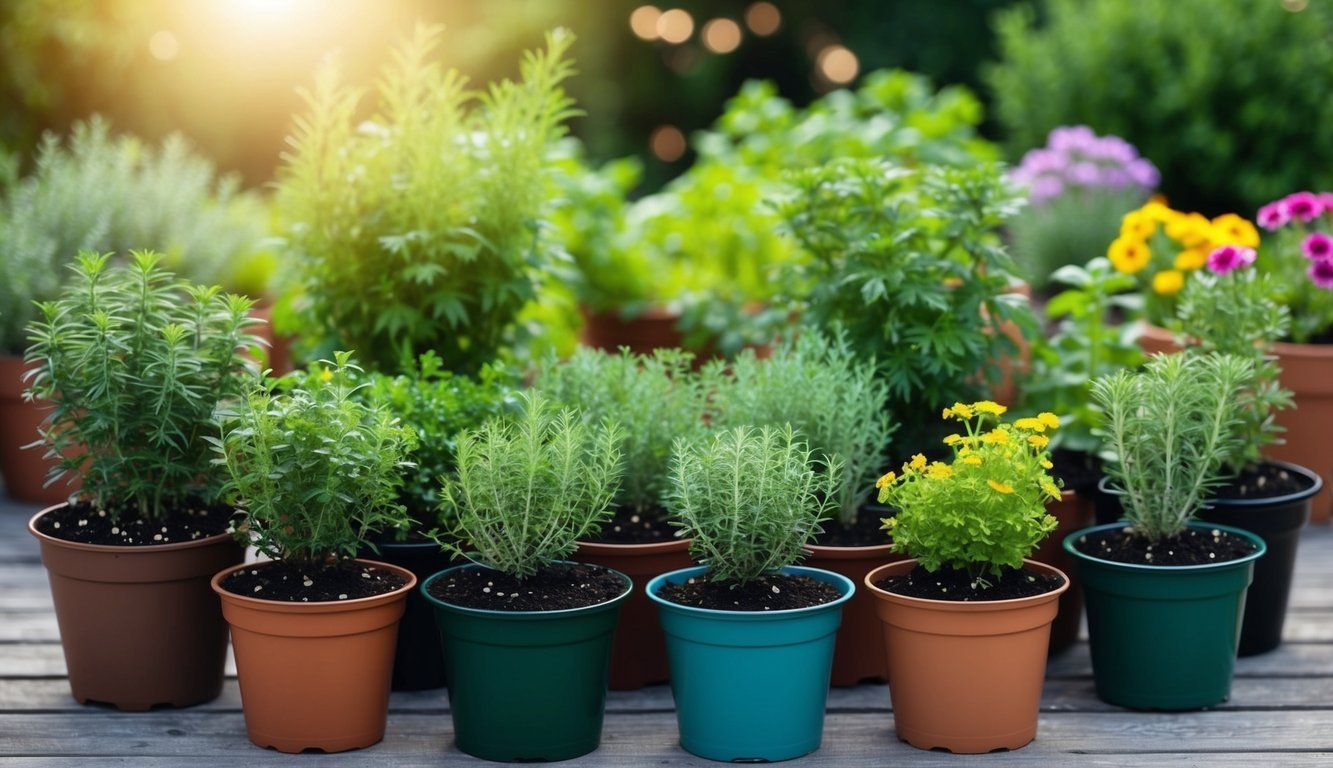
I’ve learned that well-drained soil is crucial for a low-maintenance herb garden.
Herbs typically don’t enjoy sitting in water, which can lead to root rot.
When I plant my herbs, I always ensure the soil allows excess water to escape.
Adding organic matter like compost can help improve drainage while enriching the soil.
If the soil in my garden is heavy clay, I mix in sand or perlite.
This helps create a lighter texture, perfect for growing herbs.
For container gardening, I opt for pots with drainage holes.
This method prevents water from accumulating at the bottom, which is key for herbs like basil and rosemary.
I keep an eye on my herbs, adjusting watering practices based on rainfall and temperature.
This way, I’m not drowning them in moisture.
Choosing the right soil mix makes a big difference.
A simple combination of potting soil and perlite often does the trick.
3) Use organic mulch
I’ve found that using organic mulch is one of the best tricks for a low-maintenance herb garden.
It helps to retain moisture in the soil, which means I spend less time watering.
When I spread 2 to 4 inches of organic mulch around my herbs, I also notice fewer weeds popping up.
This makes my gardening easier since I’m not constantly battling unwanted plants.
I like to mix compost into the soil when I start my garden.
Then, I can use compost as mulch on top.
This not only looks great but also adds nutrients to the soil as it breaks down.
Another bonus is the way mulch can encourage earthworms in my garden.
These little guys aerate the soil and provide extra nutrition through their castings.
In my experience, the right mulch can also help regulate soil temperature.
It keeps the roots of my herbs cozy during hot or cold spells, promoting healthier growth.
4) Water early in the morning
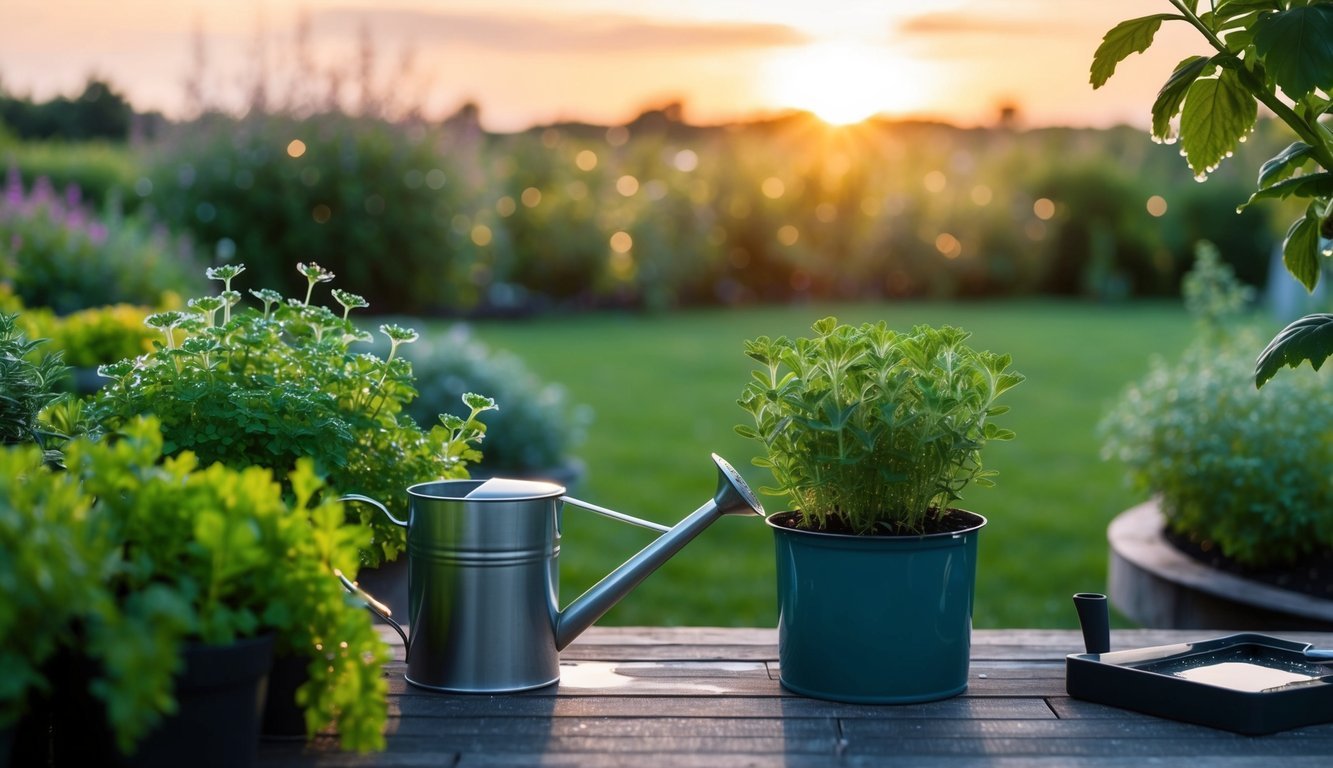
I’ve found that watering my herb garden in the early morning works wonders.
The temperatures are cooler, and there’s usually less wind.
This means more moisture gets absorbed before the sun heats things up.
Morning watering also helps prepare the plants for the day ahead.
They start off hydrated and ready to soak in the sunlight.
If I wait until later, I’ve noticed the soil can dry out quickly, leaving my herbs thirsty.
If mornings are tricky for me, I try to water in the early evening.
That way, my herbs still get some moisture before darkness falls, but I stick to mornings whenever possible.
This simple habit keeps my garden thriving without much extra effort.
5) Prune regularly for growth
I’ve learned that regular pruning is key to keeping my herbs thriving.
By trimming them often, I can encourage new growth and prevent the plants from becoming leggy.
When I prune, I remove any flowers and buds.
Those can sap the plant’s energy and limit the growth of leaves and stems.
Occasionally, I leave a few flowers if I want to collect seeds later.
Timing is essential.
I make sure not to prune about eight weeks before the first average frost date in my area.
This way, my herbs have time to recover before winter sets in.
Keeping an eye on the herbs helps too.
I check for pests or diseases during pruning, addressing any issues as they arise.
Regular maintenance keeps everything healthy and bountiful.
With consistent pruning, my herbs not only survive; they flourish.
It’s a simple habit that pays off with vibrant plants and plenty of flavors for my kitchen.
6) Group herbs by water needs
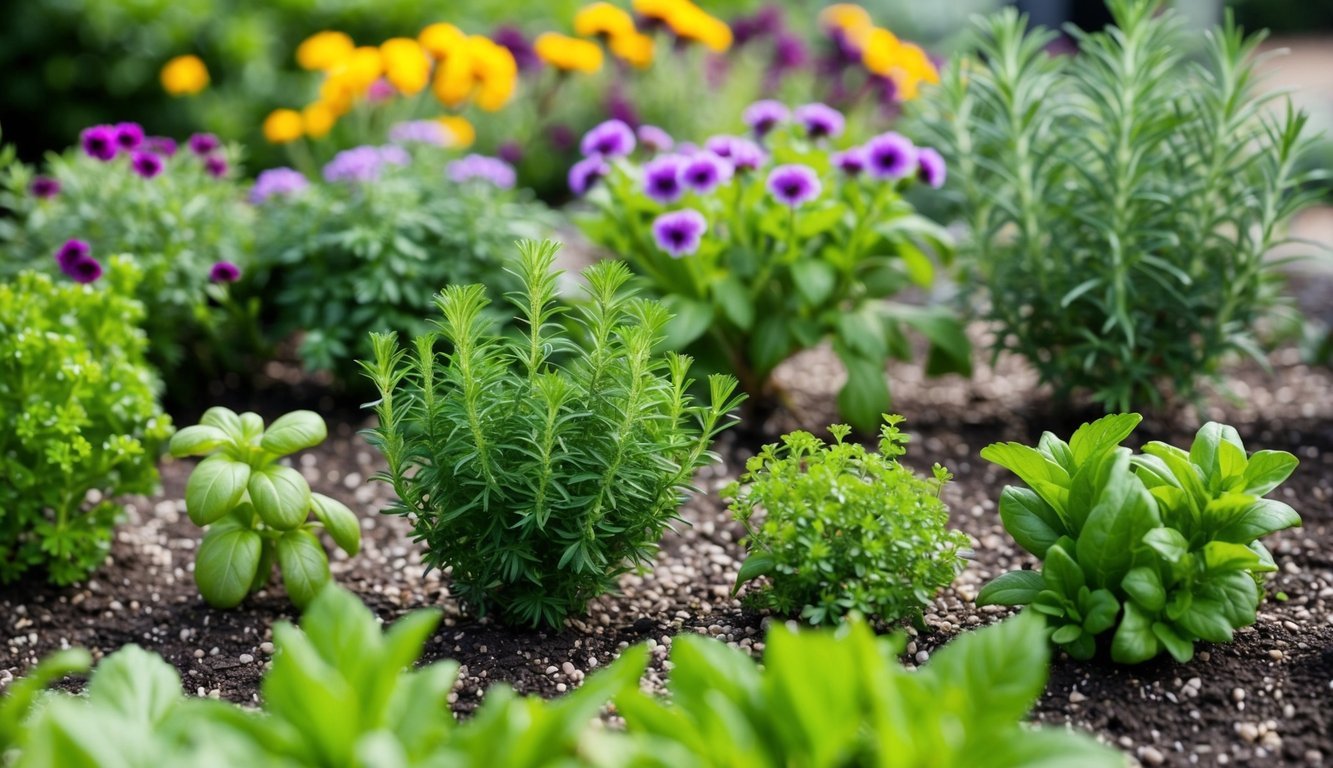
One trick I’ve found helpful is grouping herbs with similar water needs.
This makes it easier to care for them without over or under-watering.
For example, I like to keep drought-tolerant herbs like rosemary, thyme, and oregano together.
These don’t need a lot of water and thrive in well-draining soil.
They can share space and still flourish.
On the other hand, moisture-loving herbs like basil or mint prefer a more consistent amount of water.
I usually plant these in areas where they can receive regular moisture without drying out.
By organizing my herbs this way, I save time and effort in my gardening routine.
It helps me create a healthy environment tailored to each plant’s preferences.
7) Companion planting techniques
Companion planting is a simple way to boost the health of my herb garden.
By pairing certain herbs together, I can create a thriving ecosystem right in my backyard.
For instance, planting basil near tomatoes helps improve their flavor while also deterring pests.
I love how marjoram works well with most vegetables and aromatic herbs like oregano and rosemary.
Using low-growing herbs like creeping thyme as ground cover is another great hack.
It naturally suppresses weeds and keeps the soil moist without requiring too much maintenance.
Plus, it looks beautiful!
I’ve found that rotating my companion plants each season helps prevent soil depletion.
It’s a straightforward way to keep my garden healthy without excessive effort.
Dill is another favorite of mine that does well with chives, parsley, and fennel.
Its ability to repel pests makes it a great addition to my garden.
By implementing these companion planting techniques, I can enjoy a lush, low-maintenance herb garden.
It’s all about finding the right combinations that work for me.
Understanding Low-Maintenance Herbs

When diving into low-maintenance herbs, I focus on selecting the right plants and appreciating the advantages they offer.
These choices can make the gardening experience straightforward and enjoyable.
Choosing the Right Herbs
Selecting the right herbs is crucial for a successful low-maintenance garden.
I often choose forgiving varieties that thrive with minimal fuss.
Here are some great options:
- Basil: Easy to grow, it thrives in sunny spots.
- Chives: These hardy herbs can withstand varied conditions.
- Mint: Almost foolproof; just be cautious, as it can spread quickly.
These herbs are perfect for beginner gardeners.
They require minimal care once established.
Benefits of Low-Maintenance Herbs
Low-maintenance herbs provide several advantages that make them appealing.
First, they save time.
I can enjoy my garden without the constant upkeep.
Additionally, these herbs are resilient.
They typically withstand pests and fluctuating weather better than more delicate plants.
Some key benefits include:
- Easy Growth: Great for busy lifestyles.
- Flavorful Harvests: Fresh herbs enhance my cooking.
- Sustainability: Growing my herbs reduces trips to the store.
With these herbs, I can enjoy gardening without feeling overwhelmed.
Soil and Planting Basics
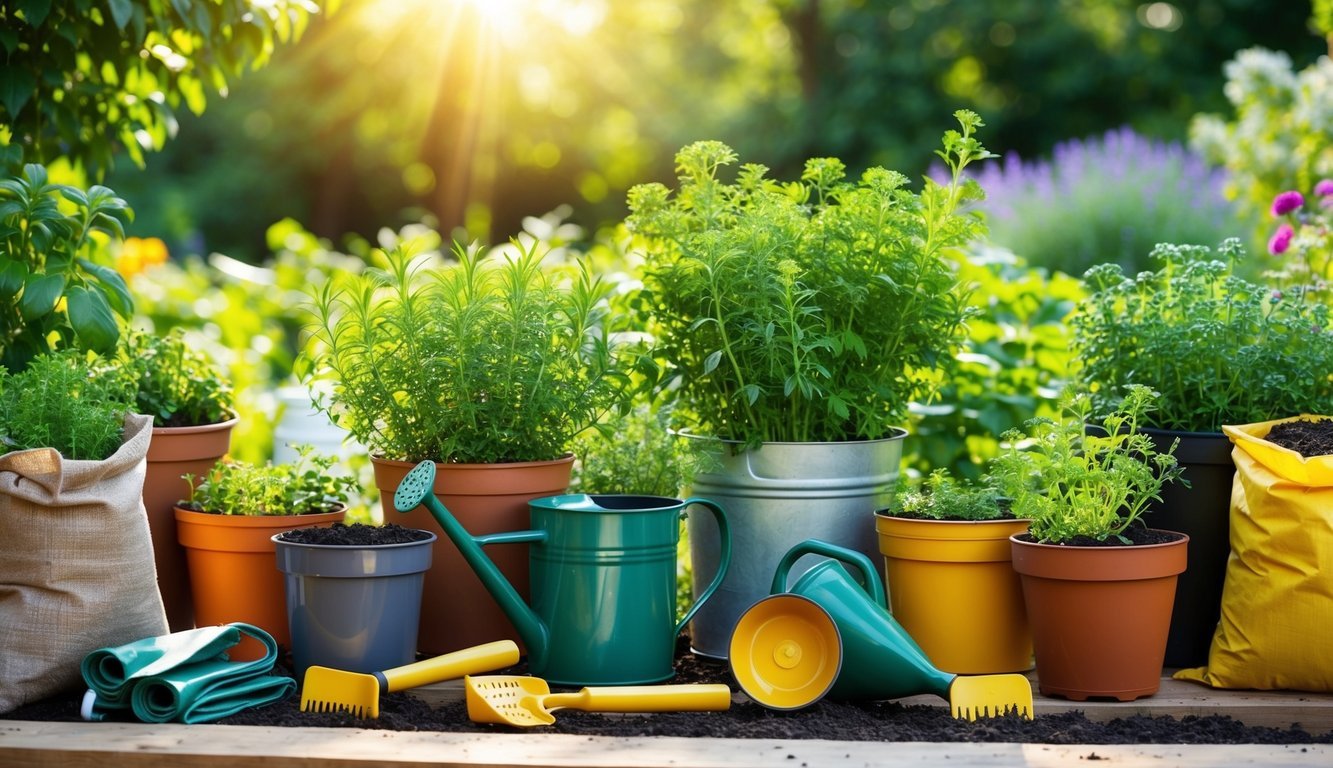
Getting the right soil and understanding planting basics is essential for a thriving herb garden.
This section covers ideal soil conditions and tips for container gardening, helping you set the stage for success.
Ideal Soil Conditions
For herbs, well-draining soil is key.
I prefer a mix that includes:
- Topsoil: Provides the base and nutrients.
- Compost: Enriches the soil with organic matter.
- Sand: Improves drainage.
A good ratio might be 2 parts topsoil, 1 part compost, and 1 part sand.
The pH level should be around 6.0 to 7.0, as most herbs enjoy slightly acidic to neutral conditions.
You can test your soil with a simple pH test kit from a garden center.
Having the right texture helps prevent root rot, which is critical for herb health.
Mix in some organic mulch to retain moisture while keeping weeds at bay.
Container Gardening Tips
Container gardening is a fantastic way to grow herbs with minimal fuss.
When choosing containers, I stick to pots that are at least 6-12 inches deep to allow for root growth.
Make sure your pots have drainage holes.
This prevents water from pooling at the bottom and causing root rot.
I often use terracotta pots, as they allow moisture to evaporate, preventing overwatering.
When planting, space the herbs correctly; I’d suggest about 6-12 inches apart, depending on the variety.
This ensures that each plant has room to grow and thrive without becoming overcrowded.
Happy planting!
Herb Garden Maintenance Tips
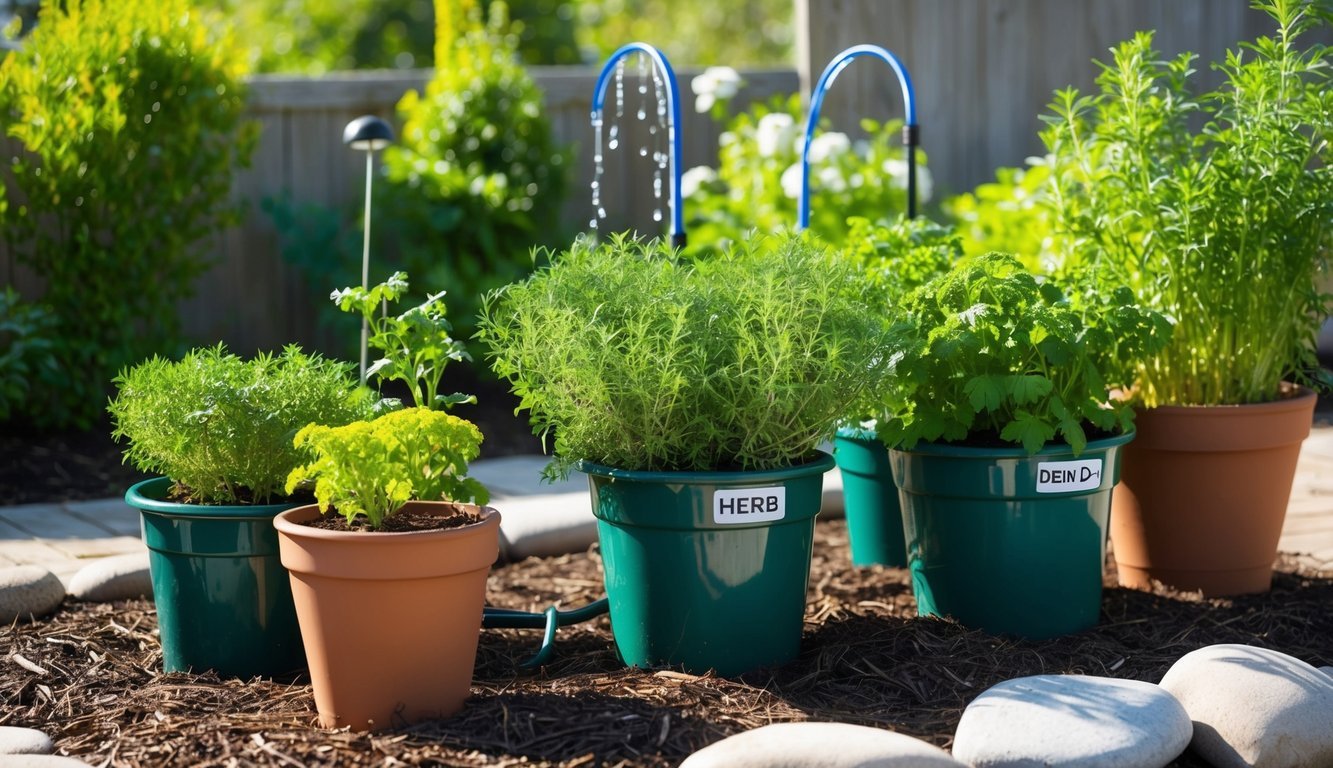
Keeping my herb garden thriving takes a bit of attention but isn’t overwhelming.
Focused watering and pest management can make a significant difference in reducing maintenance efforts while ensuring healthy plants.
Watering Techniques
I find that my herbs thrive with a consistent watering schedule.
Herbs generally prefer to dry out between watering, so I check the soil moisture first.
If the top inch feels dry, it’s time to water.
Using drip irrigation or self-watering containers can be a game changer.
These methods deliver moisture directly to the roots, preventing overwatering and ensuring even hydration.
It’s also helpful to water early in the morning or late afternoon to minimize evaporation.
In hotter months, I adjust the frequency based on the weather, as herbs may require more water during their peak growth times.
Pest Management Solutions
When it comes to pests, I keep an eye out for common culprits like aphids, spider mites, and whiteflies.
By regularly inspecting my plants, I catch any infestations early.
If I see pests, I often use a simple spray of water to dislodge them.
Another effective method is introducing beneficial insects like ladybugs or lacewings.
These natural predators help control pest populations without harming my herbs.
I also sometimes make a homemade spray using a mixture of soap and water.
This solution targets soft-bodied insects without risking damage to my plants.
Regularly checking my herbs and using these solutions keeps my garden healthy and low-maintenance.

